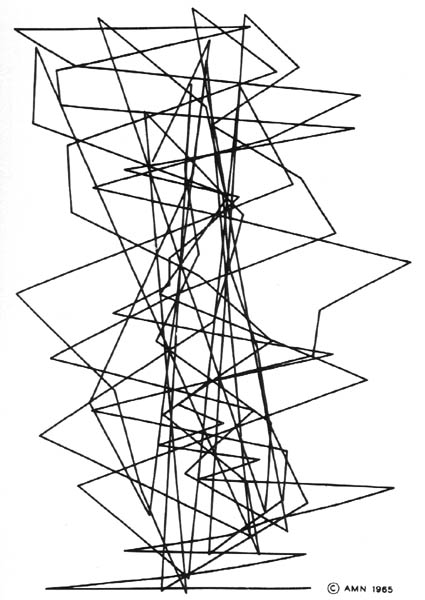<<Previous – Up – Next>>
As Lynn White remarks, technical innovations often prefigured, indeed enabled, the scientific discussion to explain their properties.[1] Likewise, the computer’s role in art was often prefigured by developments in computer graphics. Serendipitous realisations of their resemblance to “art” led to certain engineers attempting to make Computer Art. The outstanding example of this is when A. Michael Noll, a computer programmer at Bell Labs, looked at a malfunctioning print-out in 1962 and grasped its similarity to contemporary abstract art. This chance revelation inspired him to experiment artistically with the computer. As Noll said of this seminal event:
[…] a computer-generated plot of data […] had gone astray because of some programming error. […] We joked about the abstract computer art that he had inadvertently generated. It then occurred to me to use the computer, an IBM 7090, and the Stromberg Carlson plotter to create computer art deliberately. Thus my experiments in computer art began in the summer of 1962 at Bell Labs.[2]
[Plate VI: A. Michael Noll, Gaussian Quadratic, 1962.]
Apart from such accidental discoveries, artists turned to the computer to fulfil specific needs, often experimental and novel, not because it presented a complete and coherent visual solution. They often looked to the computer as a way of making art that could not be achieved otherwise. In Noll’s case, this art presented itself in the course of using the computer; this was unsurprising at a time when the computer was hardly an obvious avenue for artistic experimentation and its visual properties not widely appreciated. The adoption of the computer for art was not in general the result of a particular theoretical or polemical stance, but rather due to a simple desire for experimentation and pushing its boundaries. That last is very much in keeping with the technological attitude identified by White.
The experimental nature of early Computer Art meant that it was often regarded as an adjunct to “computer graphics”, a term coined by William Fetter of Boeing in 1960 to refer to the aircraft simulations he was developing. Indeed, the first “Computer Art” competitions were Archived 20/2/2012 by computer graphics magazines, and often produced art that consciously imitated the abstract forms current in the early 1960s. For instance, Noll claimed that he found Gaussian Quadratic, his first serious piece of computer art, reminiscent of Picasso’s cubism: “Since there was no physical reality to motivate the work, it can perhaps be considered a combination of abstraction and cubism.”[3]
Early Computer Art was inextricably linked with the advance of graphics technology, and although the two became more distinct with the passage of time, techniques developed by artists were often influential in the wider area of graphics. At this point, when computer knowledge was generally restricted to universities and research centres, there was a considerable overlap between artists and computer scientists. Many artists needed to collaborate with technicians in order to use the computer, a situation which the Experiments in Art and Technology (EAT) group attempted to formalise. However, these collaborations often resulted in an unequal weighting being given to the artist’s contribution, sidelining the necessary technological input from the engineer. The Bell Labs researcher who supported many computer artists in their work, Ken Knowlton, eventually became dispirited with this inequality and left the field. His complaints are considered in the following chapter. Suffice it to say that “art” is generally tied to a single artist – even when it is patently a group work– whereas a design project is somehow larger and more inclusive, often the product of a team and recognised as such.
Also, the promotion of much graphics work as “Computer Art” led some to question the artistic status of computer images. The most satisfying artwork seemed to come from artists who learned to program and – in at least one case – engineered their own computers.
Advances in Computer Art often supported and furthered computer graphics; whilst (as Gary Smith and Leslie Metzei pointed out) examples of “graphics” were often accepted as “Computer Art”; the boundaries were permeable. Since this time, computer artists have sought to distance themselves from “graphics”. As mentioned above, computer graphics is often identified with extravagant demonstrations of visual tricks and the pursuit of realism, and commercial rather than artistic goals.
Here, then, is one way of distinguishing Computer Art from graphics. By examining the function of the resulting work and the intention behind it, one may determine its status. For me, it is the artistic intention which is the decisive factor in terming these works “art” rather than “graphics”. In general, illustration and graphic art is part of a wider production, often aimed at promoting certain products or events, or providing the visual content for various information sources. Computer Art, by contrast, is usually a self-contained piece with no utilitarian purpose, often supported by a particular message or theme.
[1] Lynn White, Medieval Religion and Technology: Collected Essays (Berkeley:University of California Press, 1978), 331.
[2] Noll, A. Michael “The Beginnings of Computer Art in the United States: A Memoir” Leonardo Vol. 27, No1, pp. 39-44, 1994.
[3] Noll, ibid, p40


